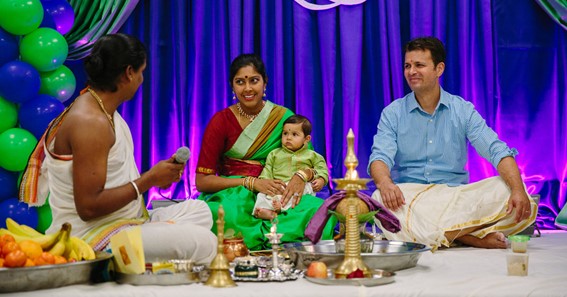Are you curious to know what is cradle ceremony? You have come to the right place as I am going to tell you everything about cradle ceremony in a very simple explanation. Without further discussion let’s begin to know what is cradle ceremony?
In many cultures around the world, welcoming a newborn into the family is a joyous occasion that is marked by various traditions and ceremonies. One such celebration is the cradle ceremony, a significant cultural event that holds great meaning and symbolism. In this blog post, we will explore what the cradle ceremony entails, its cultural significance, and the cherished traditions associated with this beautiful celebration of a new life.
What Is Cradle Ceremony?
A cradle ceremony, also known as a naming ceremony or cradle function, is a traditional event held to celebrate the arrival of a newborn baby into the family. It is a joyful occasion where friends, family members, and loved ones come together to bless and welcome the child into the world. The ceremony typically takes place within the first few months of the baby’s birth, and it varies in customs and rituals across different cultures and communities.
Cultural Significance:
-
Welcoming the Newborn:
The cradle ceremony is a way of officially welcoming the newborn into the family and the larger community. It is a time when the family celebrates the arrival of a precious life and acknowledges the baby’s presence as a cherished member of the household. The ceremony holds cultural and emotional significance as it introduces the child to their extended family and community.
-
Naming the Baby:
In many cultures, the cradle ceremony is an occasion for formally naming the baby. The name given to the child often carries deep meaning and is chosen with care, considering family traditions, cultural influences, or personal significance. The act of naming is considered auspicious and holds the belief that the name will shape the child’s identity and destiny.
-
Blessings and Wishes:
During the cradle ceremony, blessings and good wishes are bestowed upon the baby by family members and elders. This act symbolizes the desire for the child to lead a happy, healthy, and prosperous life. The blessings often include prayers for protection, wisdom, success, and a bright future.
Traditions And Customs:
-
Decorations and Rituals:
The venue for the cradle ceremony is often adorned with vibrant decorations, flowers, and auspicious symbols. Traditional rituals, prayers, and religious ceremonies are performed according to the cultural customs and beliefs of the family. These rituals may include the lighting of lamps, recitation of hymns or prayers, and offerings to deities or ancestors.
-
Cradle or Baby Swing:
A prominent feature of the cradle ceremony is the presence of a beautifully decorated cradle or baby swing. The baby is gently placed in the cradle or swing, which is then set in motion by family members, symbolizing the loving care and protection offered to the child. The swinging motion is believed to bring comfort and peace to the baby.
-
Feasting and Celebration:
The cradle ceremony is often followed by a joyous gathering, where family and friends come together to celebrate the arrival of the new baby. Traditional food, sweets, and delicacies are prepared and shared, signifying abundance and good fortune. It is a time of joy, laughter, and creating cherished memories.
Conclusion:
The cradle ceremony is a heartfelt and joyous celebration that welcomes a newborn baby into the family and community. This cultural event holds deep significance, marking the beginning of a child’s journey in life. It encompasses traditions, blessings, and rituals that connect generations, preserve cultural heritage, and strengthen family bonds. The cradle ceremony is not only a celebration of a new life but also a reflection of the love, hope, and happiness that surround the arrival of a precious little one.
FAQ
What Is Meant By Cradle Ceremony?
A cradle, or thottil, ceremony is performed usually on the 10th, 11th, 12th or 16th day of the baby’s birth to signify the baby’s independence from his or her mother. In this ceremony, a black spot is put on the baby’s forehead to ward off evil.
What Is The Procedure Of Cradle Ceremony?
On the day, the baby is given a bath, clothed and placed in a cradle. Women gather around the cradle to sing traditional songs. In the ritual, the mother is honored and the child is blessed by the elders of the family and community. The father whispers the baby’s name into its ear three times.
Is Cradle Ceremony And Naming Ceremony Same?
A new born baby has to be named and it is a mere subject of celebration. Naming ceremony is accompanied by Cradle as the child has to sleep as it will still be an infant. So Naming ceremony is also termed as Cradle Ceremony the Namakaran Samarambh” and Tottil Habba.
How Many Months Is The Cradle Ceremony?
When to do Namakarana, Naming Ceremony (Cradle Ceremony)? Namakarana is the naming ceremony celebrated for the new-born baby within 5 months time after the baby’s birth.
I Have Covered All The Following Queries And Topics In The Above Article
What Is The Meaning Of Cradle Ceremony
What Is A Cradle Ceremony
What Is Dnd In Smartwatch Samsung
What Is Dnd In Smartwatch App
What Is Dnd In Smartwatch Android
What Is Dnd In Smartwatch Amazfit
What Is Cradle Ceremony In Christianity
What Is Cradle Ceremony For Baby Girl
Cradle Ceremony Procedure In Telugu
Cradle Ceremony Meaning In Tamil
Cradle Ceremony Meaning In Hindi
Cradle Ceremony Meaning In Marathi
What Is Cradle Ceremony
Is cradle ceremony same as naming ceremony
What does cradle ceremony mean






